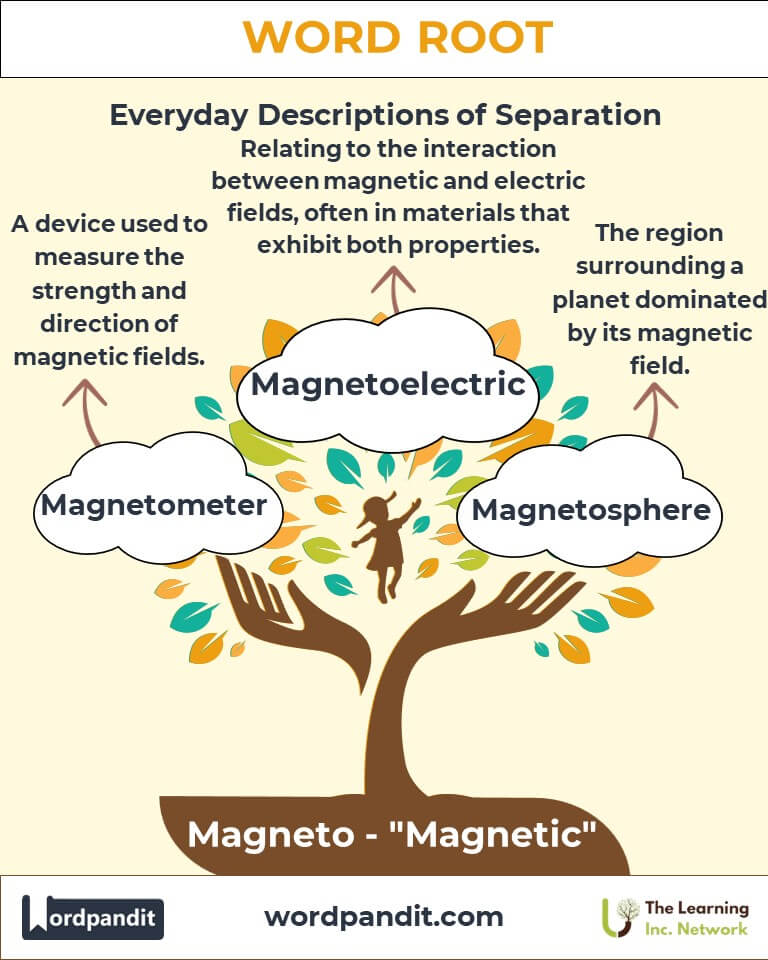Magneto: The Magnetic Connection Across Language and Science
Explore the intriguing world of the word root "magneto," originating from the Greek word for magnetic. From devices like magnetometers to phenomena like the magnetosphere, this root powers our understanding of magnetism across science and everyday language.

Table of Contents
- Introduction: The Essence of Magneto
- Etymology and Historical Journey
- Mnemonic: Unlocking the Power of Magneto
- Common Magneto-Related Terms
- Magneto Through Time
- Magneto in Specialized Fields
- Illustrative Story: Magneto in Action
- Cultural Significance of the Magneto Root
- The Magneto Family Tree
- FAQs about the Magneto Word Root
- Test Your Knowledge: Magneto Word Root Quiz
- Conclusion: The Living Legacy of Magneto
Introduction: The Essence of Magneto
Magneto (pronounced mag-nee-toh), derived from the Greek word "magnetis," refers to magnetic forces and properties. From the practical applications in technology to the mysteries of Earth's magnetosphere, "magneto" captures the universal pull of magnetism. Whether it’s in navigation, space exploration, or daily life, the root magneto is pivotal in connecting phenomena with language.

Etymology and Historical Journey
The word "magneto" originates from the Greek term magnēs lithos, meaning "stone from Magnesia," a region in Greece known for its naturally magnetic rocks. Early philosophers like Thales of Miletus observed magnetic forces, laying the foundation for studies that would expand into physics and technology.
As the term traveled through Latin and Old French into English, it broadened its meaning, encompassing natural and artificial magnetic phenomena.
Mnemonic: Unlocking the Power of Magneto
Imagine a compass needle drawn irresistibly toward the magnetic North Pole, symbolizing magneto's meaning.
Mnemonic Device: "Magneto pulls everything together, from Earth’s poles to technological marvels."
Common Magneto-Related Terms
- Magnetometer (mag-nee-tom-uh-ter):
A device that measures magnetic fields.
Example: "The magnetometer detected subtle changes in the Earth’s magnetic field during the expedition." - Magnetosphere (mag-nee-toh-sfeer):
The region surrounding a planet dominated by its magnetic field.
Example: "Earth’s magnetosphere protects us from harmful solar winds." - Magnetite (mag-nee-tite):
A naturally magnetic mineral and an important source of iron.
Example: "Ancient sailors used magnetite to craft early compasses." - Magnetron (mag-nee-tron):
A device that generates microwave radiation, commonly used in microwaves.
Example: "The microwave's magnetron converts electricity into microwaves to heat food." - Magnetize (mag-nee-tize):
To impart magnetic properties to an object.
Example: "The technician magnetized the tool to pick up metal screws easily."
Magneto Through Time
- Lodestone (Ancient): Early navigators used naturally magnetic rocks to create primitive compasses.
- Electromagnet (19th Century): The discovery of electromagnetism revolutionized communication and transport, leading to inventions like the telegraph.
- Magnetars (Modern): These highly magnetic neutron stars showcase the extreme power of magnetic forces in the cosmos.
Magneto in Specialized Fields
- Physics: Magnetodynamics examines the forces within magnetic systems.
Application: Crucial for understanding electric motors and generators. - Astronomy: Magnetosphere studies the interaction of planetary magnetic fields with solar winds.
Example: NASA's missions investigate how Earth's magnetosphere shields life. - Medicine: Magnetic Resonance Imaging (MRI) uses powerful magnets to visualize internal body structures.
Impact: Non-invasive imaging for early diagnosis of diseases. - Geology: Magnetostratigraphy determines the age of rock layers through their magnetic properties.
Relevance: Key to understanding Earth’s magnetic history.
Illustrative Story: Magneto in Action
During a space mission, astronaut Dr. Leah Fernandez used a magnetometer to study Mars’ magnetosphere. This data helped scientists understand how the absence of a strong magnetic field allowed solar winds to strip away the Martian atmosphere. Back on Earth, Leah explained how this knowledge could guide future colonization efforts. Magneto’s influence extended from space exploration to securing humanity’s survival on another planet.
Cultural Significance of the Magneto Root
The magnetic compass revolutionized navigation, enabling global exploration. In modern times, magneto-related technologies have shaped communication, healthcare, and renewable energy. Magnetism's metaphorical use in literature and art, symbolizing attraction and influence, reflects its universal appeal.

The Magneto Family Tree
- Electro- (electricity):
Electromagnet: A magnet created by an electric current.
Example: "Electromagnets are vital in electric motors and cranes." - Ferro- (iron):
Ferromagnetism: The magnetic properties of materials like iron.
Example: "Ferromagnetic materials are used in permanent magnets." - Geo- (Earth):
Geomagnetism: Earth’s magnetic field study.
Example: "Geomagnetism explains the phenomenon of auroras."
FAQs About " Magneto "
Q: What does "magneto" mean?
A: "Magneto" refers to magnetic forces or properties, derived from the Greek word "magnēs," meaning "magnet." It captures the essence of attraction and the behavior of magnetic materials, which have applications in navigation, technology, and natural phenomena like Earth's magnetic field.
Q: How does a magnetometer work?
A: A magnetometer measures the strength and direction of magnetic fields. It works by detecting the interaction between magnetic fields and electric currents or using quantum effects to sense magnetic forces. These devices are used in archaeology, space exploration, and geology to map magnetic variations.
Q: What is the magnetosphere, and why is it significant?
A: The magnetosphere is the region of space around a planet dominated by its magnetic field. Earth’s magnetosphere is crucial because it protects life by deflecting harmful solar winds and cosmic radiation. Without it, the atmosphere would be stripped away, making life as we know it impossible.
Q: What is ferromagnetism?
A: Ferromagnetism is a property of certain materials, such as iron, cobalt, and nickel, where atomic magnetic moments align to produce a strong magnetic effect. This property is the foundation of permanent magnets and is essential in creating electric motors, generators, and magnetic storage devices.
Q: Can all materials become magnetic?
A: No, only specific materials—ferromagnetic ones like iron and nickel—can be permanently magnetized. Some materials, like paramagnetic substances, only exhibit weak magnetism in the presence of a magnetic field, while others, like diamagnetic substances, repel magnetic fields.
Q: How is magnetism used in medical imaging?
A: Magnetic Resonance Imaging (MRI) uses strong magnetic fields and radio waves to create detailed images of internal body structures. It relies on the magnetic properties of hydrogen atoms in the body, which align with the field and emit signals that are translated into images, revolutionizing non-invasive diagnosis.
Q: What causes the Earth’s magnetic field?
A: Earth’s magnetic field is generated by the movement of molten iron and nickel in the outer core, a process known as the geodynamo. This field extends into space, forming the magnetosphere, which shields the planet from harmful radiation and helps guide compasses for navigation.
Q: Why is magnetite important in history and technology?
A: Magnetite, a naturally magnetic mineral, was vital in ancient navigation, as early sailors used it to make primitive compasses. Today, it remains significant in scientific studies of Earth's magnetic history and in various industrial applications, including ore processing and magnetic storage media.
Test Your Knowledge: " Magneto " Mastery Quiz
1. What does "magneto" signify?
2. What is a magnetometer used for?
3. What protects Earth from solar winds?
4. Which mineral is naturally magnetic?
5. What does ferromagnetism describe?
Conclusion: The Living Legacy of Magneto
The root magneto captures the essence of attraction, force, and connection, shaping our understanding of natural and technological phenomena. From ancient lodestones to modern magnetic imaging, its influence permeates science, culture, and innovation. As we delve deeper into magnetism, "magneto" remains a guiding force in discovery and progress.












